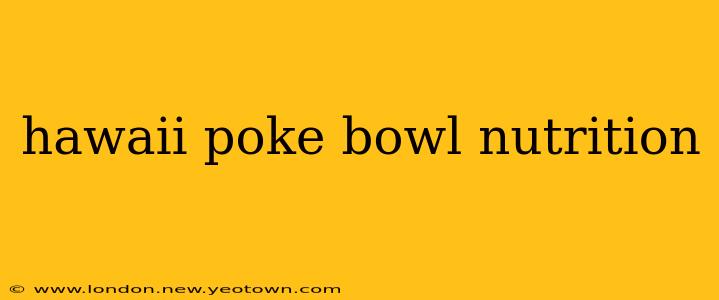The vibrant colors, the refreshing flavors, the satisfying textures – Hawaiian poke bowls have taken the world by storm. But beyond the deliciousness, lies a question many health-conscious eaters ponder: what's the nutritional profile of this trendy dish? Let's dive into the nutritional details, exploring the benefits and potential drawbacks of this popular meal.
Imagine this: you're on a sun-drenched Hawaiian beach, the gentle ocean breeze caressing your face. You take a bite of your poke bowl, the cool, fresh fish melding perfectly with the sweetness of the mango and the crunch of the edamame. That's the essence of a poke bowl – a delightful culinary experience with a surprisingly healthy foundation.
What are the main ingredients in a Hawaiian poke bowl and their nutritional value?
The nutritional powerhouse of a poke bowl stems from its core ingredients. The star, of course, is the raw fish, typically ahi tuna or salmon, packed with high-quality protein crucial for building and repairing tissues. Protein also helps you feel full and satisfied, making it a great choice for weight management. Fish is also an excellent source of omega-3 fatty acids, known for their anti-inflammatory properties and heart health benefits. These essential fats aren't produced by our bodies, making dietary sources like fish all the more important.
Beyond the fish, the foundation of a good poke bowl usually includes brown rice or quinoa, offering complex carbohydrates for sustained energy. These whole grains also provide valuable fiber, crucial for digestive health and blood sugar regulation. Then there's the array of vegetables, which add vitamins, minerals, and antioxidants, enhancing the bowl's nutritional profile. Think vibrant additions like seaweed salad, edamame, cucumbers, and avocado. The avocado in particular adds healthy fats, further bolstering the bowl's nutritional value.
How many calories are in a typical Hawaiian poke bowl?
The calorie count of a poke bowl can fluctuate significantly depending on the ingredients and portion sizes. A typical poke bowl might range from 400 to 800 calories, depending on the protein source (tuna is usually lower in calories than salmon), the type of base (brown rice is typically higher in calories than quinoa), and the amount of added sauces and toppings. For example, a bowl heavy on creamy sauces like mayonnaise-based dressings will naturally contain more calories than one made with lighter options like soy sauce or a simple vinaigrette.
Is a Hawaiian poke bowl healthy?
Yes, a well-constructed Hawaiian poke bowl can indeed be a healthy meal option. Its high protein content keeps you full, the omega-3s are beneficial for heart health, and the abundance of vegetables provides essential vitamins and minerals. However, the nutritional value can vary greatly depending on the ingredients chosen and portion control. Opting for lean protein, whole grains, and plenty of vegetables while minimizing high-calorie sauces and toppings will maximize the health benefits.
What are the potential health benefits of eating Hawaiian poke bowls?
Regularly enjoying well-balanced poke bowls can provide numerous health benefits:
- Improved Heart Health: The omega-3 fatty acids in the fish are potent allies in reducing the risk of heart disease.
- Weight Management: The high protein and fiber content can contribute to weight loss or maintenance by promoting satiety.
- Increased Energy Levels: The complex carbohydrates provide sustained energy throughout the day, avoiding the energy crashes associated with simple sugars.
- Boosted Immunity: The diverse range of vegetables contributes to a robust immune system due to their rich vitamin and mineral content.
What are some healthy alternatives or modifications to make a Hawaiian poke bowl even healthier?
You can further optimize the healthiness of your poke bowl with a few simple tweaks:
- Choose lean protein: Opt for leaner cuts of fish like tuna over richer options like salmon if calorie control is a priority.
- Go for whole grains: Select brown rice or quinoa as your base over white rice for added fiber and nutrients.
- Load up on veggies: The more vegetables, the better! Experiment with a wide variety of colorful options.
- Use lighter sauces: Opt for low-sodium soy sauce, a light vinaigrette, or a squeeze of lime instead of creamy, high-calorie sauces.
- Watch portion sizes: Be mindful of the quantity of rice and other higher-calorie ingredients you include.
Are there any potential downsides or risks associated with eating Hawaiian poke bowls?
While generally healthy, there are some potential downsides to consider:
- Mercury levels in fish: Some types of fish, especially larger predatory species, can contain higher levels of mercury. Opt for smaller, lower-mercury fish varieties.
- Food safety: It's crucial to ensure the fish used is fresh and handled properly to minimize the risk of foodborne illness. Opt for reputable establishments with high standards of food safety.
- Sodium content: Some sauces, especially soy sauce, can be high in sodium. Be mindful of your sodium intake.
- Hidden Calories: Creamy sauces and large portions of rice can easily inflate the calorie count, potentially undermining the health benefits.
Enjoy your Hawaiian poke bowls responsibly! By being mindful of your ingredient choices and portion sizes, you can enjoy this flavorful and healthy meal as a regular part of a balanced diet.

